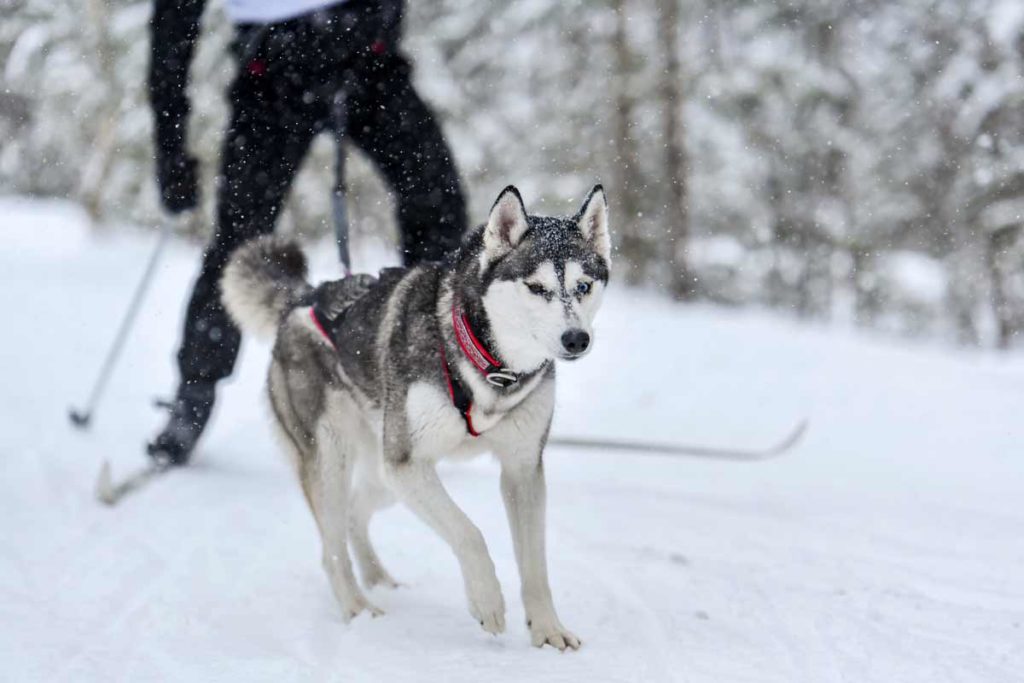If you’re the kind of person that thrives in the cold and snow, chances are you want to spend your winter weekends in the great outdoors. And where’s the fun in having all those adventures without your best fur friend by your side? The cold weather doesn’t necessarily mean you have to reduce your dog walks together to a shivery bathroom break. If you and your dog are already fit and healthy adventure partners, there’s every reason you can continue your escapades together – whatever the weather may bring.
However, when dealing with snow, ice, and freezing temperatures, there are extra preparations and precautions to consider before hitting the trail. Taking the time to research your route, invest in good gear, and create a plan for emergencies will offer peace of mind and reduce the risk of accidents or injury to you or your dog during an epic winter excursion.
Table of contents
- Dog-friendly winter sports
- Best dog breeds for winter adventure
- How to prepare your dog for winter sports
- Winter sports with your dog: Know the risks
Dog-friendly winter sports
Introduce your dog to any of these sports slowly and safely and you can keep the adrenaline pumping all year long. Given the challenging terrain and conditions that winter sports typically offer, most require your dog to remain off-lash for the majority of the activity. As a result, excellent off-leash skills, obedience, and good recall are essential to avoid your dog getting lost or injured along the way.
- Snowshoeing – It’s walking – but with special shoes! Perhaps the easiest way to begin your winter adventures is with a snowshoe expedition into the great white beyond. As long as your dog is fit and healthy, it should be able to traverse the deep snow with you.
- Winter hikes – Do you spend the summer bagging summits with your pup? Then you can likely rise to the challenge of winter hiking together, too. In winter weather, you’ll need to come extra prepared with additional layers, food, and gear since the physical demands and safety stakes can be much greater. Furthermore, hiking trails tend to be much quieter during the cold season, so your chances of finding help in an emergency are reduced. Even on packed trails, pet parents will likely need to bring microspikes for traversing icy sections. Your dog will also need to be nimble and surefooted, so make sure you research trail conditions and think realistically about what you can both manage. If undertaken with care, the views and solitude of the winter trails and mountaintops can be breathtakingly spectacular – and worth all the extra prep.
- Nordic or skate skiing – The smooth and relatively flat terrain of Nordic skiing trails makes it an easy entry-level activity for you and your dog to try. The steady but elevated pace will offer you both a solid workout and ensure your body temperatures stay high enough to fend off the winter chill. You can choose to pack trails and create a route yourself or find a public trail system that offers groomed ski trails for a smoother ride. However, it’s important to check if your local Nordic/skate ski area is dog-friendly or offers dual trails for dog access before you go.
- Fat biking – Does your dog like to join bike rides already? Then they’ll probably thrive on groomed fat bike trails in the winter when extended runs come without the risk of overheating.
- Winter camping – Winter camping with your dog requires an extra load of gear to ensure your dog is kept comfortable and warm in the frozen outdoors. Car camping in a designated campsite is the easiest way to go about things, but if you’re intrepid and willing to carry or sled your and your pup’s belongings, the backcountry is calling! And, luckily, you two are so close because all but the hardiest Nordic breeds will need to sleep inside the tent during the night to stay warm and dry enough throughout the night. You may even want to invest in a coat or dog bed to bring along in case of extreme cold. In addition, it’s important to keep an eye on your dog around camp, when they could stray off into the dark. A light-up collar will help increase visibility, but an ID tag and microchipping are essentials.
- Ski touring – At the extreme end of winter endurance adventures, ski touring is only for the most experienced pet and parent combo. Requiring adapted alpine skis designed to allow you to trek up and ski down a mountain, the sport is more accessible to ski-bums and their pooches than any resort, but the physical challenges of climbing up and descending elevation in the snow means the risk of injury is significant. Ask yourself if your dog is the right breed, age, and health for such an adventure before skinning up any mountains.
Best dog breeds for winter adventure
If you’re ready to adopt or buy a dog and winter sports play a significant role in your life, it’s worth considering what kind of dog breed or mix would suit your lifestyle and allow you both to spend the maximum time doing what you love together. A Chihuahua won’t share the same level of stoke about spending long days in the frigid air. In general, miniature breeds lack the body mass to stay warm and comfortable in freezing temperatures – similar to especially skinny dog breeds like whippets, greyhounds, and lurchers, who have little insulation and inclination for the snow.
The breeds that are most adept at snow sports are those that were traditionally bred for hunting, herding, and hauling in colder climates – go figure. Breeds that hail from mountainous regions and harsh climates, such as the Alps, Alaska, and Nepal, were selected for their hardiness and endurance in the face of adverse conditions. Most boast thick paws and ears that are less prone to frostbite, as well as double coats, which consist of a woolly underlayer covered with long hairs that traps heat against the body. Dogs like Malamutes, Great Pyrenees, Bernese Mountain Dogs, Tibetan terriers, Chow Chow, and Akita – or dogs with a mix of these bloodlines – will cope better than short-haired breeds in the cold. They may even prefer colder temperatures, seeking to sleep outdoors in all but the harshest cold.
How to prepare your dog for winter sports
Even the most well-adapted dogs will need some extra care to stay happy and healthy in winter. Before you embark on a winter adventure with your dog in tow, pack up and prepare the following items.
Fun fact: larger dogs can even wear a specialty fitted backpack and carry some of their own supplies!
Layers
Winter sports enthusiasts can’t afford to be light packers. Most winter activities involve cycling between cold and hot, wet and dry as you exert your body in mixed weather conditions. The same goes for your dog, who, even if they have a thick double coat, might require an additional waterproof jacket. You can also bring along a fitted sweatshirt or extra blankets for any moments when you stop to have lunch or set up camp. If your dog gets wet, it will lose body heat fast, so the extra layers can function as toweling tools to get them dry quickly and avoid a chill setting in.
Snacks
At home, snacks might be a treat or reward for good behavior. On the trails and snowy slopes, snacks are a necessity to keep your dog warm, energized, and able to keep moving through the cold. When deciding how much dog food to bring, you will need to consider a few variables: length of trip, mileage, forecasted weather/temperatures, and your dog’s overall age and health. In general, you can calculate the length of the excursion and determine what your dog usually eats within this timeframe – then increase the calorie intake by roughly 50%. High-calories and high-protein foods pack the most punch compared to weight.
Water
It might seem counterintuitive, but it’s possible your dog’s water consumption increases during winter. This is because the humidity in the air typically drops during the winter, which can affect hydration levels. On top of this, they will expend more energy to keep warm, which also requires proper hydration to counteract exertion and insensible water loss. And eating snow alone won’t cut it, and can come with risks of contamination. Make sure you stop and offer your dog a drink frequently during your adventure, but try to keep it stored somewhere insulated. Serving them ice-cold water will lower the core body temperature.
Lights/harness
Most winter sports require strong off-leash skills. Even so, a sturdy harness is a valuable tool for keeping a dog secure in the snow. If your dog falls through ice or into a deep snow drift or hidden ravine, a harness with a backstrap could help you to haul them out in an emergency. Furthermore, it gives you somewhere secure to attach reflective material and lights to keep them visible and safe in the dark.
Paws
The canine metacarpal/metatarsal and toe pads are designed for a certain amount of endurance, but freezing snow and ice, as well as grit and salt, can take a harsh toll on the paws. Ice can easily ball up on fur, particularly among the toes, causing irritation and sores to develop. Keep a close eye on your dog’s feet and attempt to wipe them clean and dry whenever possible. Before you go, apply a thick protective layer of petroleum jelly or specially-formulated balm as a preventative method to protect against sore paws.
Winter sports with your dog: Know the risks
Even with the best preparation in the world, things can go wrong on the trail. In cold weather, serious situations can get severe quickly. Make sure you have a game plan for what to do when the universe throws you a curveball.
Before you go
Make sure your dog is in good health before you even leave the house. Ask yourself honestly if your pet has the youth, energy, health, and temperament to endure a full day of activity in cold weather.
Ensure all ID and medical tags are attached to your dog’s collar or harness in the case of an accident or separation. Bring along the contact information for your veterinarian and an emergency clinic, as well as any emergency or mountain rescue details relevant to your area, so you know exactly who to go to if things go wrong.
On the trail
Keep a close eye on your pet as you go. The snow and ice can hide unforeseen risks. Monitor how they are moving and behaving, keeping a close eye out for limping or changes in behavior, such as lethargy and attempting to burrow, which can be signs of hypothermia or frostbite.
Back at home
Once you’re safely home and happily exhausted from your adventure, even the youngest and healthiest dog might suffer some residual soreness. Consider a CBD + CBDA supplement to help them counteract the physical strain of winter sports during the colder months.
ElleVet’s CBD + CBDA is proven safe and effective in clinical trials for helping dogs by modulating the perception of discomfort. This helps them maintain comfortable joint function. Not only this, our CBD + CBDA chews, soft gels, and oils can help to regulate any stress reaction provoked as a result of ongoing discomfort.
For any questions about ElleVet’s CBD + CBDA products or how CBD can help your canine friend live their best life, give us a call (844-673-7287) or send us an email ([email protected]). We are here to help.









